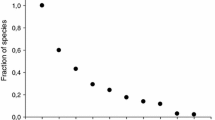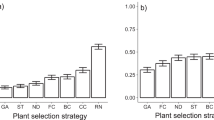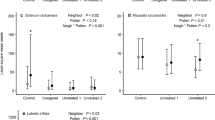As our research teaches, the bee groups in question, in view of their detailed adjustments apparently ab origine, were very closely linked to oil flowers. This emerges directly from: their partnership as their legitimate pollination symbionts, from the concordance of their geographic ranges, and the very close mutual relationships.
S. Vogel, 1974.
Abstract
Quaternary climatic changes impacted species’ demography and distribution worldwide. Although response to climate change could have been modulated by mutualistic interactions with other species, studies exploring the dynamics of these interactions and their role facilitating species persistence during past climatic variations are scarce. In this work, we attempt to explore the spatial dynamic of Calceolaria polyrhiza and its oil-collecting bee pollinators during the last 120,000 years, identifying stable areas of persistence and statistically determining whether the distribution of pollinator-related floral ecotypes is associated with these shared areas of persistence. To do this, we used 395 presence records of the interacting species and constructed species palaeodistribution models. Additionally, we gathered phenotypic measures of the plant and used decision tree and multiple regression analyses to link the plant phenotypic divergence with the distribution of stable areas. Our species distribution models suggest that past climatic changes affected the interaction between C. polyrhiza and both bee species in time and space. While the interaction between the plant and C. caeruleus predominated in the Andean-Patagonian forest and was relatively stable in space and time, that was not the case for the pollinator C. cineraria in the Patagonian steppe. This, along with our analyses of spatial phenotypic divergence, indicates that current floral phenotypes are the result of two historical different pollination regimes.




Similar content being viewed by others
References
Acosta MC, Mathiasen P, Premoli AC (2014) Retracing the evolutionary history of Nothofagus in its geo-climatic context: new developments in the emerging field of phylogeology. Geobiology 12:497–510. doi:10.1111/gbi.12098
Alsos IG, Engelskjøn T, Gielly L, Taberlet P, Brochmann C (2005) Impact of ice ages on circumpolar molecular diversity: insights from an ecological key species. Mol Ecol 14:2739–2753. doi:10.1111/j.1365-294X.2005.02621.x
Anderson RP (2016) When and how should biotic interactions be considered in models of species niches and distributions? J Biogeogr. doi:10.1111/jbi.12825
Baranzelli MC, Sérsic AN, Cocucci AA (2014a) The search for Pleiades in trait constellations: functional integration and phenotypic selection in the complex flowers of Morrenia brachystephana (Apocynaceae). J Evol Biol 27:724–736. doi:10.1111/jeb.12341
Baranzelli MC, Johnson LA, Cosacov A, Sérsic AN (2014b) Historical and ecological divergence among populations of Monttea chilensis (Plantaginaceae), an endemic endangered shrub bordering the Atacama Desert, Chile. Evol Ecol 28:751–774. doi:10.1007/s10682-014-9694-y
Barreda V, Guler V, Palazzesi L (2008) Late Miocene continental and marine palynological assemblages from Patagonia. In: Rabassa J (ed) The late Cenozoic of Patagonia and Tierra del Fuego. Elsevier, Oxford, pp 343–349. doi:10.1016/S1571-0866(07)10016-6
Bates DM, Maechler M (2010) lme4: linear mixed-effects models using S4 Classes. R package version 0.999375-36/r1083
Beheregaray LB (2008) Twenty years of phylogeography: the state of the field and the challenges for the Southern Hemisphere. Mol Ecol 17:3754–3774. doi:10.1111/j.1365-294X.2008.03857.x
Benitez-Vieyra S, Medina M, Glinos E, Cocucci AA (2006) Pollinator-mediated selection on floral traits and size of floral display in Cyclopogon elatus, a sweat bee-pollinated orchid. Funct Ecol 20:948–957. doi:10.1111/j.1365-2435.2006.01179.x
Bronstein JL, Dieckmann U, Ferrière R (2004) Coevolutionary dynamics and the conservation of mutualisms. In: Ferrière R, Dieckmann U, Couvet D (eds) Evolutionary conservation biology. Cambridge University Press, Cambridge, pp 305–326
Buchmann SL (1987) The ecology of oil flowers and their bees. Annu Rev Ecol Evol Syst 18:343–369. http://www.jstor.org/stable/2097136
Cocucci AA, Sérsic A, Roig-Alsina A (2000) Oil-Collecting structures in Tapinotaspidini: their diversity, function and probable origin (Hymenoptera: Apidae). Mitt Münch Ent Ges 90:51–74
Cosacov A (2010) Patrones de variación de caracteres fenotípicos y frecuencias génicas en el rango de distribución de la especie endémica de Patagonia Calceolaria polyrhiza: su relación con variables ambientales, polinizadores y factores históricos Tesis de Doctorado. Universidad Nacional de Córdoba, Córdoba
Cosacov A, Nattero J, Cocucci AA (2008) Variation of pollinator assemblages and pollen limitation in a locally specialized system: the oil-producing Nierembergia linariifolia (Solanaceae). Ann Bot 102:723–734. doi:10.1093/aob/mcn154
Cosacov A, Sérsic AN, Sosa V, De-Nova JA, Nylinder S, Cocucci AA (2009) New insights into the phylogenetic relationships, character evolution, and phytogeographic patterns of Calceolaria (Calceolariaceae). Am J Bot 96:2240–2255. doi:10.3732/ajb.0900165
Cosacov A, Sérsic A, Sosa V, Johnson LA, Cocucci AA (2010) Multiple periglacial refugia in the Patagonian steppe and post-glacial colonization of the Andes: the phylogeography of Calceolaria polyrhiza. J Biogeogr 37:1463–1477. doi:10.1111/j.1365-2699.2010.02307.x
Cosacov A, Cocucci AA, Sérsic AN (2012) Variación geográfica de la recompensa floral de Calceolaria polyrhiza (Calceolariaceae): influencia de factores bióticos y abióticos. Bol Soc Argent Bot 47:363–373
Cosacov A, Johnson LA, Paiaro V, Cocucci AA, Córdoba FE, Sérsic AN (2013) Precipitation rather than temperature influenced the phylogeography of the endemic shrub Anarthrophyllum desideratum in the Patagonian steppe. J Biogeogr 40:168–182. doi:10.1111/j.1365-2699.2012.02776.x
Cosacov A, Cocucci AA, Sérsic AN (2014) Geographical differentiation in floral traits across the distribution range of the Patagonian oil-secreting Calceolaria polyrhiza: do pollinators matter? Ann Bot 113:251–266. doi:10.3732/ajb.93.6.917
Davis AJ, Jenkinson LS, Lawton JH (1998) Making mistakes when predicting shifts in species range in response to global warming. Nature 391:783–786. doi:10.1038/35842
Ehrhart C (2000) Die Gattung Calceolaria (Scrophulariaceae) in Chile. Bibl Bot 153:1–283
Elith J, Leathwick JR (2009) Species distribution models: ecological explanation and prediction across space and time. Annu Rev Ecol Evol Syst 40:677–697. doi:10.1146/annurev.ecolsys.110308.120159
Elnaggar AA, Noller JS (2010) Application of remote-sensing data and decision-tree analysis to mapping salt-affected soils over large areas. Remote Sens 2:151–165. doi:10.3390/rs2010151
Espíndola A, Pellissier L, Maiorano L, Hordijk W, Guisan A, Alvarez N (2012) Predicting present and future intra-specific genetic structure through niche hindcasting across 24 millennia. Ecol Lett 15:649–657. doi:10.1111/j.1461-0248.2012.01779.x
Espíndola A, Carstens BC, Alvarez N (2014) Comparative phylogeography of mutualists and the effect of the host on the genetic structure of its partners. Biol J Linn Soc 113:1021–1035. doi:10.1111/bij.12393
Fraser CI, Nikula R, Ruzzante DE, Waters JM (2012) Poleward bound: biological impacts of Southern Hemisphere glaciation. Trends Ecol Evol 27:462–471. doi:10.1016/j.tree.2012.04.011
Friedl MA, Brodley CE (1997) Decision tree classification of land cover from remotely sensed data. Remote Sens Environ 61:399–409. doi:10.1016/S0034-4257(97)00049-7
Gavin DG, Fitzpatric MC, Gugger PF et al (2014) Climate refugia: joint inference from fossil records, species distribution models and phylogeography. New Phytol 204:37–54. doi:10.1111/nph.12929
Hewitt GM (1996) Some genetic consequences of ice ages, and their role in divergence and speciation. Biol J Linnean Soc 58:247–276. doi:10.1111/j.1095-8312.1996.tb01434.x
Hewitt GM (2000) The genetic legacy of the quaternary ice ages. Nature 405:907–913. doi:10.1038/35016000
Hickerson MJ, Carstens BC, Cavender-Bares J, Crandall KA, Graham CH, Johnson JB, Rissler L, Victoriano PF, Yoder AD (2010) Phylogeography’s past, present, and future: 10 years after Avise 2000. Mol Phylogenet Evol 54:291–301. doi:10.1016/j.ympev.2009.09.016
Hijmans RJ, Cameron SE, Parra JL, Jones PG, Jarvis A (2005) Very high resolution interpolated climate surfaces for global land areas. Int J Climatol 25:1965–1978. doi:10.1002/joc.1276
Hosner PA, Sanchez-Gonzalez LA, Peterson AT, Moyle RG (2014) Climate-driven diversification and Pleistocene refugia in Philippine birds: evidence from phylogeographic structure and paleo-environmental niche modeling. Evolution 68:2658–2674. doi:10.1111/evo.12459
Jakob SS, Martínez-Meyer E, Blattner FR (2009) Phylogeographic analyses and paleodistribution modeling indicate Pleistocene in situ survival of Hordeum species (Poaceae) in southern Patagonia without genetic or spatial restriction. Mol Biol Evol 26:907–923. doi:10.1093/molbev/msp012
Johnson SD, Steiner KE (2000) Generalization versus specialization in plant pollination systems. Trends Ecol Evol 15:140–143. doi:10.1371/journal.pone.0041878
Leppe M, Mihoc M, Varela N, Stinnesbeck W, Mansilla H, Bierma H, Cisterna K, Frey E, Jujihara T (2012) Evolution of the Austral-Antarctic flora during the Cretaceous: new insights from a paleobiogeographic perspective. Revista Chilena de Historia Natural 85:369–392
Machado IC (2004) Oil-collecting bees and related plants: a review of the studies in the last twenty years and case histories of plants occurring in NE Brazil. In: Freitas M, Pereira JOP (eds) Solitary bees, conservation, rearing and management for pollination: a contribution to the International Workshop on Solitary Bees and their Role in Pollination. Imprensa Universitaria, Fortaleza, pp 252–282
Martins AC, Aguiar AJ, Alves-dos-Santos I (2013) Interaction between oil-collecting bees and seven species of Plantaginaceae. Flora 208:401–411. doi:10.3732/ajb.1400470
Maubecin CC, Cosacov A, Sérsic AN, Fornoni J, Benitez-Vieyra S (2016) Drift effects on the multivariate floral phenotype of Calceolaria polyrhiza during a post-glacial expansion in Patagonia. J Evol Biol 29:1523–1534. doi:10.1111/jeb.12889
Merow C, Smith MJ, Silander JA (2013) A practical guide to MaxEnt for modeling species’ distributions: what it does, and why inputs and settings matter. Ecography 36:1058–1069. doi:10.1111/j.1600-0587.2013.07872.x
Molau U (1988) Scrophulariaceae-Part I. Calceolarieae. Flora. Neotropica 47:1–326. doi:10.4067/S0717-66432012000200007
Mraz P, Gaudeul M, Rioux D, Gielly L, Choler P, Taberlet P (2007) Genetic structure of Hypochaeris uniflora (Asteraceae) suggests vicariance in the Carpathians and rapid post-glacial colonization of the Alps from an eastern Alpine refugium. J Biogeogr 34:2100–2114. doi:10.1111/j.1365-2699.2007.01765.x
Murúa M, Espíndola A (2015) Pollination syndromes in a specialised plant–pollinator interaction: does floral morphology predict pollinators in Calceolaria? Plant Biol 17:551–557. doi:10.1111/plb.12225
Murúa M, Cisterna J, Rosende B (2014) Pollination ecology and breeding system of two Calceolaria species in Chile. Rev Chil Hist Nat 87:1–3. doi:10.1186/0717-6317-87-7
Neff JL, Simpson BB (2005) Other rewards: oils, resins, and gums. In: Dafni A, Kevan PG, Husband BC (eds) Practical pollination biology. Enviroquest, Ontario, pp 314–328
Nicola MV, Sede SM, Pozner R, Johnson LA (2014) Phylogeography and palaeodistribution modelling of Nassauvia subgenus Strongyloma (Asteraceae): exploring phylogeographical scenarios in the Patagonian steppe. Ecol Evol 4(22):4270–4286. doi:10.1002/ece3.1268
Okuda M, Nishida H, Uemura K, Yabe A (2006) Paleocene/Eocene pollen assemblages from the Ligorio Marquez Formation, Central Patagonia, XI Region, Chile. In: Nishida H (ed) Post-cretaceous floristic changes in southern Patagonia, Chile. Chuo University, Tokyo, pp 37–43
Otto-Bliesner BL, Marshall SJ, Overpeck JT et al (2006) Simulating Arctic climate warmth and icefield retreat in the last interglaciation. Science 311:1751–1753. doi:10.1126/science.1120808
Owens HL, Campbell LP, Dornak LL et al (2013) Constraints on interpretation of ecological niche models by limited environmental ranges on calibration areas. Ecol Model 263:10–18. doi:10.1016/j.ecolmodel.2013.04.011
Peter CI, Johnson SD (2014) A pollinator shift explains floral divergence in an orchid species complex in South Africa. Ann Bot 113:277–288. doi:10.1093/aob/mct216
Phillips SJ, Anderson RP, Schapire RE (2006) Maximum entropy modeling of species geographic distributions. Ecol Model 190:231–259. doi:10.1016/j.ecolmodel.2005.03.026
Prates I, Xue AT, Brown JL, Alvarado-Serrano DF, Rodrigues MT, Hickerson MJ, Carnaval AC (2016) Inferring responses to climate dynamics from historical demography in neotropical forest lizards. Proc Natl Acad Sci USA 113:7978–7985. doi:10.1073/pnas.1601063113
QGIS Development Team (2016) QGIS geographic information system. Open Source Geospatial Foundation Project. http://www.qgis.org/
Rabassa J (2008) Late Cenozoic glaciations in Patagonia and Tierra del Fuego. In: Rabassa J (ed) The late Cenozoic of Patagonia and Tierra del Fuego. Elsevier, Oxford, pp 151–204
Renner SS, Schaefer H (2010) The evolution and loss of oil-offering flowers: new insights from dated phylogenies for angiosperms and bees. Phil Trans R Soc B 365:423–435. doi:10.1098/rstb.2009.0229
Rodríguez-Gómez F, Gutiérrez-Rodríguez C, Ornelas JF (2013) Genetic, phenotypic and ecological divergence with gene flow at the Isthmus of Tehuantepec: the case of the azure-crowned hummingbird (Amazilia cyanocephala). J Biogeogr 40:1360–1373. doi:10.1111/jbi.12093
Roig-Alsina A (1999) Revisión de las abejas colectoras de aceites del género Chalepogenus Holmberg (Hymenoptera, Apidae, Tapinotaspidini). Rev Mus Argent Cienc Nat 1:67–101
Roig-Alsina A (2000) Claves para las especies argentinas de Centris (Hymenoptera, Apidae) con descripción de nuevas especies y notas sobre su distribución. Rev Mus Argent Cienc Nat 2:171–193
Sede SM, Nicola MV, Pozner R, Johnson LA (2012) Phylogeography and palaeodistribution modelling in the Patagonian steppe: the case of Mulinum spinosum (Apiaceae). J Biogeogr 39:1041–1057. doi:10.1111/j.1365-2699.2011.02662.x
Sérsic AN (2004) Reproductive biology of the genus Calceolaria. Stapfia 82:1–121
Sérsic AN, Cosacov A, Cocucci AA, Johnson LA, Pozner R, Avila LJ, Sites JW Jr, Morando M (2011) Emerging phylogeographical patterns of plants and terrestrial vertebrates from Patagonia. Biol J Linnean Soc 103:475–494. doi:10.1111/j.1095-8312.2011.01656.x
Simpson BB, Neff JL (1981) Floral rewards: alternatives to pollen and nectar. Ann Mo Bot Gard 68:301–322. doi:10.2307/2398800
Taberlet P, Fumagalli L, Wust-Saucy AG, Cosson JF (1998) Comparative phylogeography and post-glacial colonization routes in Europe. Mol Ecol 7:453–464. doi:10.1046/j.1365-294x.1998.00289.x
Thompson AR, Thacker CE, Shaw EY (2005) Phylogeography of marine mutualists: parallel patterns of genetic structure between obligate goby and shrimp partners. Mol Ecol 14:3557–3572. doi:10.1111/j.1365-294X.2005.02686.x
Tribsch A, Schonswetter P (2003) Patterns of endemism and comparative phylogeography confirm palaeoenvironmental evidence for Pleistocene refugia in the Eastern Alps. Taxonomy 52:477–497. http://www.jstor.org/stable/3647447
Triponez Y, Arrigo N, Espíndola A, Alvarez N (2015) Decoupled post-glacial history in mutualistic plant–insect interactions: insights from the yellow loosestrife (Lysimachia vulgaris) and its associated oil-collecting bees (Macropis europaea and M. fulvipes). J Biogeogr 42:630–640. doi:10.1111/jbi.12456
Turchetto-Zolet A, Pinheiro F, Salgueiro F, Palma-Silva C (2013) Phylogeographical patterns shed light on evolutionary process in South America. Mol Ecol 22:1193–1213. doi:10.1111/mec.12164
Valiente-Banuet A, Rumebe AV, Verdú M, Callaway RM (2006) Modern Quaternary plant lineages promote diversity through facilitation of ancient Tertiary lineages. Proc Natl Acad Sci USA 103:16812–16817. doi:10.1073/pnas.0604933103
Vogel S (1974) Ölblumen und ölsammelnde Bienen. Akademieder Wissenschaften und der Literatur, Mathematisch Naturwissenschaftliche Klasse 7:285–547
Vogel S (1988) Die Ölblumensymbiosen: parallelismus und andere Aspekte ihrer Entwicklung in Raum und Zeit. Zeitschrift für Zoologische Systematik und Evolutionsforschung 26:341–362
Waltari E, Hijmans RJ, Peterson AT, Nyári ÁS, Perkins SL, Guralnick RP (2007) Locating Pleistocene refugia: comparing phylogeographic and ecological niche model predictions. PLoS ONE 2(7):e563. doi:10.1371/journal.pone.0000563
Wilf P, Johnson KR, Cúneo NR, Smith ME, Singer BS, Gandolfo MA (2005) Eocene plant diversity at Laguna del Hunco and Río Pichileufú, Patagonia, Argentina. Am Nat 165:634–650. doi:10.1086/430055
Wisz MS, Pottier J, Kissling WD et al (2013) The role of biotic interactions in shaping distributions and realised assemblages of species: implications for species distribution modelling. Biol Rev 88:15–30. doi:10.1111/j.1469-185X.2012.00235.x
Zuur AF, Ieno EN, Walker NJ, Saveliev AA, Smith GM (2009) Zero-truncated and zero-inflated models for count data. In: Zuur AF (ed) Mixed effects models and extensions in ecology with R. Statistics for Biology and Health. Springer, New York, pp 261–293. doi:10.1007/978-0-387-87458-6_11
Acknowledgements
We thank A.A. Cocucci for field assistance, S. Benítez Vieyra for his statistical assistance/guidance and M. Latvis for correcting the English. We also thank APN Argentina for permits to work in populations located in parks and reserves. A.C. and A.N.S. acknowledge the National Research Council of Argentina (CONICET) as researchers and M.S.P. and M.C.B. as a doctoral and postdoctoral fellowship holder, respectively. A.E. acknowledges the Swiss National Science Foundation (Grants P300P3_151141 and PBNEP3_140192). This work was supported by the National Research Council of Argentina (PIP 201101-00245; A.N.S.); National Ministry of Science and Technology (FONCYT-PICT-2011-0837; A.N.S. and 2011-0709; A.C.); and the Systematic Research Fund (A.C.).
Author information
Authors and Affiliations
Corresponding author
Additional information
Handling Editor: Isabel Alves dos Santos.
M. Sosa-Pivatto, A. Cosacov, M. C. Baranzelli and A. N. Sérsic have contributed equally to this study and should be considered as co-first authors.
Electronic supplementary material
Below is the link to the electronic supplementary material.
Rights and permissions
About this article
Cite this article
Sosa-Pivatto, M., Cosacov, A., Baranzelli, M.C. et al. Do 120,000 years of plant–pollinator interactions predict floral phenotype divergence in Calceolaria polyrhiza? A reconstruction using species distribution models. Arthropod-Plant Interactions 11, 351–361 (2017). https://doi.org/10.1007/s11829-016-9490-4
Received:
Accepted:
Published:
Issue Date:
DOI: https://doi.org/10.1007/s11829-016-9490-4




